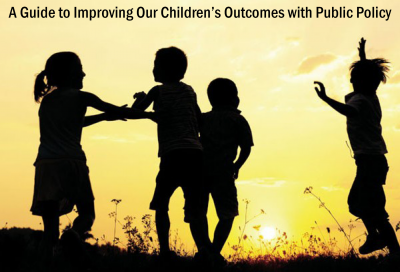
by Amber Wallin, MPA
New Mexico has a long and proud history of close-knit community and of cutting-edge innovation in many fields, so making progress on child well-being is within our reach if we fully commit to it. To that end, New Mexico Voices for Children is pleased to share our newest guide for improving KIDS COUNT rankings in New Mexico. Though New Mexico ranked poorly compared to other states in the 2017 national KIDS COUNT rankings, there are many areas where New Mexico had made progress through policy improvements. For example, 31,000 more New Mexico kids have health care access due to the expansion of Medicaid under the Affordable Care Act; and, since 2010, 4,100 more New Mexico kids have access to NM Pre-K and 3,700 more to state-funded home visiting services. Teen birth rates and teen drug and alcohol abuse rates are also showing significant improvement. There is a long way yet to go, but there are many areas where we’re making progress, and these areas show that we have the power to make positive changes for our kids and that we can do it through public policy.
With that in mind, we researched the potential for positive change in each of the 16 indicators of the KIDS COUNT index with the intent of improving opportunities for New Mexico’s children. We looked at how far away we were from other states on each measure. We identified areas where New Mexico has the greatest opportunities for improvement: where positive change was most attainable and accessible: where we were closest to improving not just our indicator rankings, but more importantly, our outcomes: and how we could do it. Because each KIDS COUNT indicator is closely linked to long-term family and childhood well-being and opportunity, improving outcomes in even one indicator will benefit vulnerable children and increase their probability for success.
Summary Findings
Through the project, the following indicators were identified as the areas where New Mexico has the greatest potential to not only to directly improve outcomes through policy improvements, but also where New Mexico is close to overtaking other states in rankings.
- Young children not in school
- Low-birthweight babies
- Child and teen deaths
- Teen alcohol and drug abuse
- Teens not in school and not working
- Teen birth rates
In some of these areas, just a 2 percent change would have improved New Mexico’s 2017 rankings in that indicator area by five or more spots. In other indicators, by improving outcomes for fewer than 200 children we would have done better than national average in that indicator.
The surest way to realize that kind of progress is through policy change. And just as some indicator areas show incredible potential for improvement, some policy recommendations show enormous potential for improving conditions for New Mexico kids across multiple indicators. The following policy recommendations—all of them evidence-based and tied by research to improved child well-being—cross-cut many indicator areas and should be considered some of the highest-leverage policy solutions for improving opportunities for children in our state:
- Improve family economic security by expanding access to various adult education programs; increase incomes through tax credits, decrease burdensome expenses by increasing eligibility for child care assistance and enacting tougher restrictions on predatory lending, and raise wages by increasing the minimum wage.
- Improve educational outcomes for children by expanding high-quality early childhood care and education services, quality before- and after-school, mentorship, and tutoring programs, increasing funding to schools in high-poverty areas, and expanding K-3 Plus.
- Improve health outcomes by expanding mental health programs for children, youth and families, fully funding Medicaid and simplifying and streamlining Medicaid enrollment, and increasing funding and support for school-based health centers (SBHCs) and county and tribal health councils.
Too frequently in the past, we’ve starved our state budget. We’ve reward the wealthiest, the most well-connected, and the biggest corporations with tax cuts. Then we’ve underfunded programs crucial to New Mexico kids and families in order to pay for those giveaways. Fundamental to all of the recommendations included in this report is a fair, responsible, and transparent tax system that generates sufficient revenues to support those crucial programs and services.
New Mexico Is at a Crossroads
In the following pages, you will find current and historical data on each of the 16 KIDS COUNT indicators as well as analyses of what it would take to improve outcomes and rankings in each indicator. We also include high-leverage and realistic policy recommendations on how to get there. However, revisiting data and policy recommendations doesn’t improve child well-being unless there is the political will to put the needs of our children—and their future—first. The upcoming elections present the opportunity for candidates to promote these smart and common-sense policy recommendations and to craft plans for how they will make children a priority when the hard work of crafting budgets and tax policies needs to be done.
The 2018 elections provide the opportunity to chart a new course—one that will raise enough revenue for the programs that our kids need to thrive. A new course that will invest in our most important assets and those most critical to our state’s prosperity—our children. When children have access to the opportunities and resources they need to reach their full potential society benefits. By investing in New Mexico kids and families, we will make our communities, economy, and state stronger; and using data to guide those investments is the smartest course of action to guarantee our state’s future success.
A Note on KIDS COUNT Rankings
The Annie E. Casey Foundation has been ranking the 50 states on overall child well-being for more than two decades. To determine the rankings, the KIDS COUNT program looks at 16 indicators, which are organized under four domains (economic well-being, education, health, and family and community). Each of the domains and indicators are ranked. These rankings are then used to determine the states’ overall rankings. However, it’s important to note that while states cannot tie on the overall rankings, they can tie on the indicator rankings.
For example, New Mexico’s overall rank for 2017 is 49th. This means that 48 states ranked higher than New Mexico and one ranked worse. Not so with the indicator rankings. For example, New Mexico ranked 5th for the indicator “teens who abuse alcohol and drugs” in 2017—but so did 29 other states, which all had the same percentage of teens abusing alcohol and drugs. In all, four states tied for 1st on that indicator, 30 states (including New Mexico) tied for 5th, and 16 states tied for 35th. Because states can tie on indicator rankings, a small change in outcomes can mean a much larger jump in terms of ranking. In other words, a small improvement in the percentage of teens who abuse alcohol and drugs could have meant New Mexico was ranked anywhere from 1st to 4th, depending on how many other states did just as well.
In addition, New Mexico’s ranking in any given year is the result of more than just how well New Mexico did on that particular indicator that year. It also depends on how well the other 49 states fared. Ranking improvement estimates in this report are based on point-in-time data reported in 2017; changes in other states’ outcomes can also influence New Mexico’s future rankings.
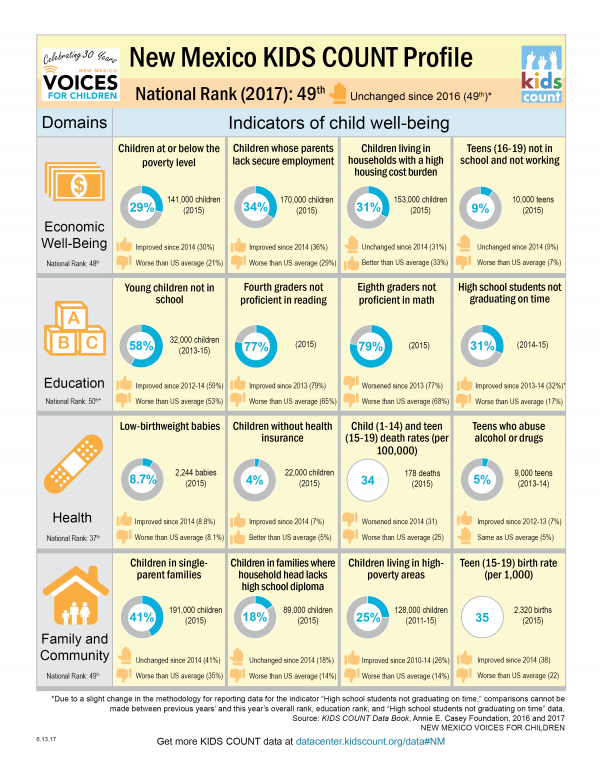
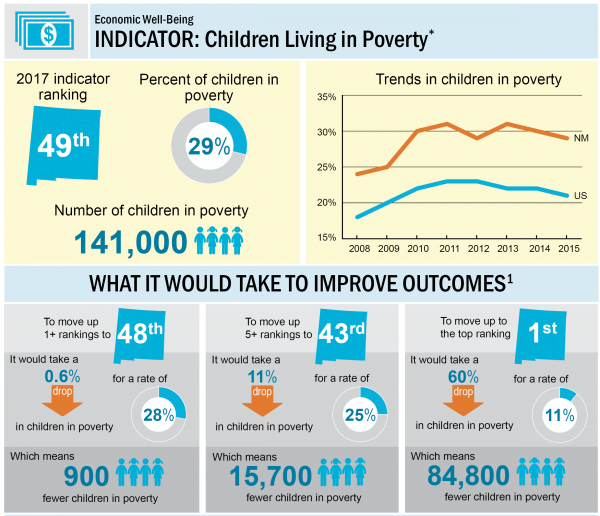 *Children living in families with incomes below $24,036 for a family of two adults and two children (in 2015 dollars).
*Children living in families with incomes below $24,036 for a family of two adults and two children (in 2015 dollars).
What New Mexico Can Do
- Increase eligibility levels for child care assistance to at least 200 percent of the federal poverty level.
- Raise the state’s minimum wage and index it to rise with inflation, raise the tipped wage to 60 percent of the minimum wage, and enact policies to prevent wage theft.
- Increase refundable tax credits like the Working Families Tax Credit (WFTC) and the Low Income Comprehensive Tax Rebate (LICTR), and enact a more progressive income tax system.
- Enact tougher restrictions on predatory loans (payday, car title loans, etc.).
- Support and promote the availability of resources and assistance for kinship foster care families and grandparents helping to raise their grandchildren, including access to financial resources, legal services, food and housing assistance, medical care, and transportation.
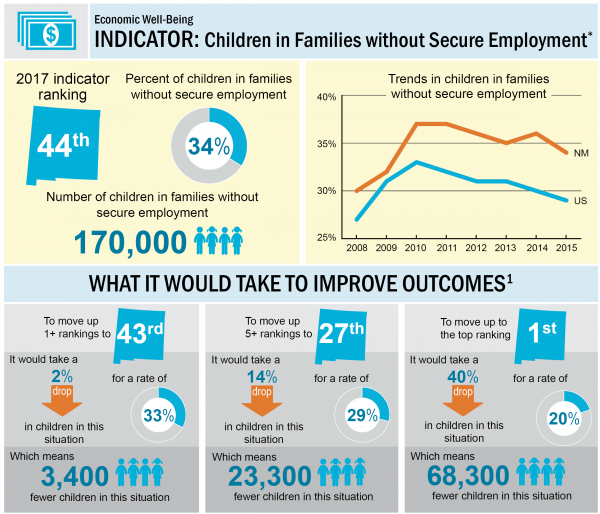 *Children (ages 0-17) living in families where no parent had full-time, year-round employment.
*Children (ages 0-17) living in families where no parent had full-time, year-round employment.
What New Mexico Can Do
- Increase eligibility levels for child care assistance to at least 200 percent of the federal poverty level.
- Expand access to high school equivalency, job training, career pathways programs, and adult basic education (ABE) including English as a second language (ESL) classes.
- Target federal funds (Workforce Innovation and Opportunity Act or WIOA and Temporary Assistance for Needy Families or TANF) to support bridge and career pathways programs that help low-skill parents earn high school equivalency diplomas and industry-recognized credentials in in-demand occupations.
- Target WIOA and TANF funds to better serve parents with significant barriers to employment through on-the-job training, paid internships, and subsidized or transitional employment.
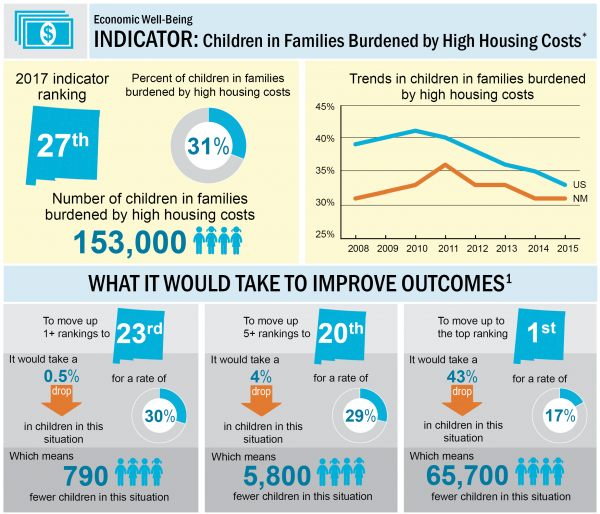 *Children (ages 0-17) in households that spend more than 30 percent of their income on housing.
*Children (ages 0-17) in households that spend more than 30 percent of their income on housing.
What New Mexico Can Do
- Increase funding for the Housing Trust Fund so more quality housing for low- and moderate-income families can be built providing more children with stable, safe homes.
- Save the Home Loan Protection Act from repeal or reduction to protect more families from predatory lending practices that can lead to home foreclosure.
- Enact a rate cap of 36 percent APR (including fees) on all lending products so that families are not caught in cycles of increasing debt and can save for home purchases.
- Increase funding for the Low Income Home Energy Assistance Program (LIHEAP).
- Increase funding for Individual Development Accounts (IDAs), which help parents and children save money for buying a home.
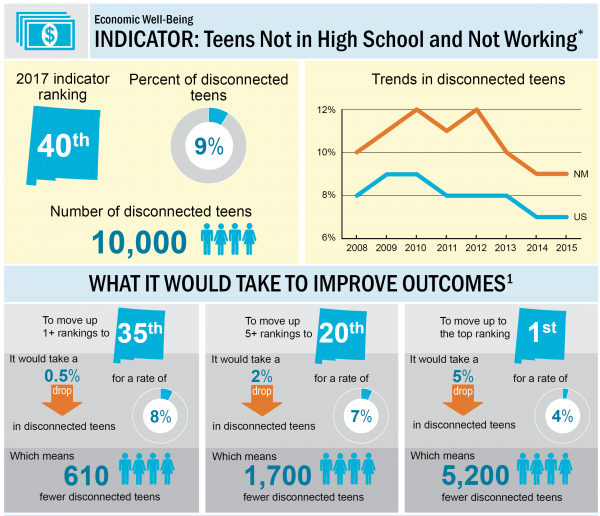 *Teens (ages 16-19) not attending school and not working, also known as ‘disconnected teens.’
*Teens (ages 16-19) not attending school and not working, also known as ‘disconnected teens.’
What New Mexico Can Do
- Enact initiatives to lower the cost of college—such as making the lottery scholarship need-based and restoring the College Affordability Fund.
- Develop a state youth employment strategy using a career pathways approach which includes business, nonprofits, government, school districts, and higher education—to help identify and provide support for disconnected youth.
- Provide support for vulnerable high school students (those experiencing homelessness, who are incarcerated, need special education, are English language learners, etc.) who are at risk for dropping out.
- Implement systems to identify and address chronic absenteeism.
- Fund alternative high schools and evidence-based drop-out prevention programs, as well as drop-out recovery programs that combine education, job training, and youth development.
- Expand access to education-oriented youth employment and career exploration programs including paid summer jobs and internships, on-the-job training, career technical education (CTE), and pre-apprenticeships.
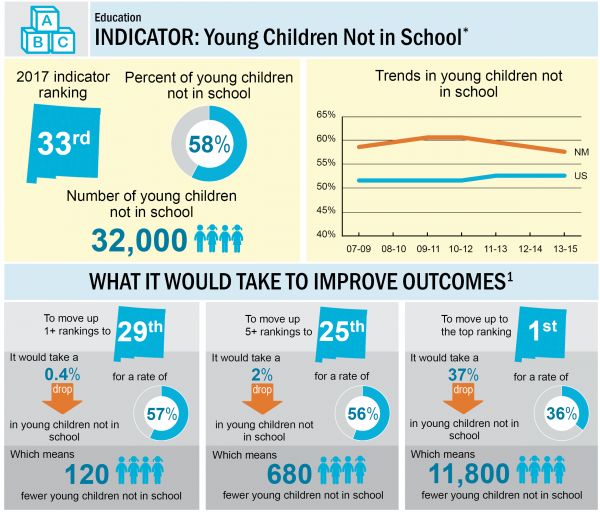 *Children (ages 3-4) not attending an institution providing educational experiences (including nursery school, preschool, pre-K, Head Start, and kindergarten).
*Children (ages 3-4) not attending an institution providing educational experiences (including nursery school, preschool, pre-K, Head Start, and kindergarten).
What New Mexico Can Do
- Increase spending on high-quality pre-K so it is available to all 4-year-olds, is available as a full-day program, and is available for more 3-year-olds.
- Increase eligibility for child care assistance to at least 200 percent of the federal poverty level.
- Increase availability of universal, voluntary, high-quality home visiting in order to support families while also educating parents on the value of early learning.
- Increase funding for child care to incentivize and adequately compensate for quality.
- Promote coordination between Head Start, PED, and CYFD on early childhood programs.
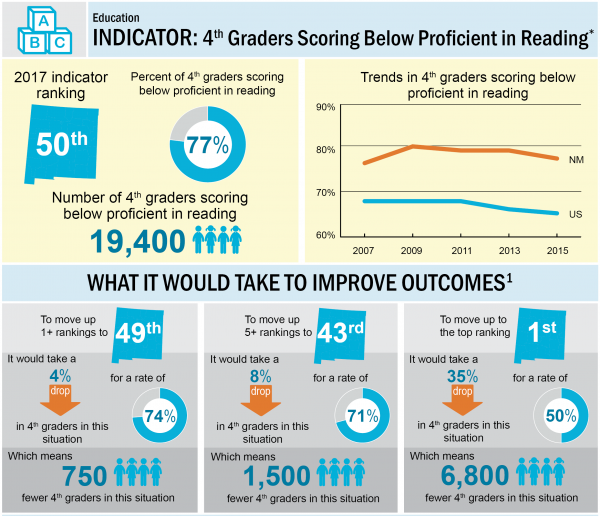 *Fourth graders scoring below proficient in reading on the National Assessment of Education Progress (NAEP).
*Fourth graders scoring below proficient in reading on the National Assessment of Education Progress (NAEP).
What New Mexico Can Do
- Expand high-quality early childhood care and education services to help prepare children for school and increase the likelihood they will reach grade-level benchmarks on time.
- Expand funding for K-3 Plus so more low-income students will have the additional quality instructional time.
- Expand K-3 Plus to a K-8 Plus program because children in low-income families still need extra supports beyond 3rd grade.
- Expand quality before- and after-school, mentorship, and tutoring programs to provide added academic assistance to low-income and low-performing students, or those whose parents may not be able to help them with their homework.
- Increase the availability of reading coaches and support evidence-based reading initiatives.
- Implement systems to identify and address chronic absenteeism.
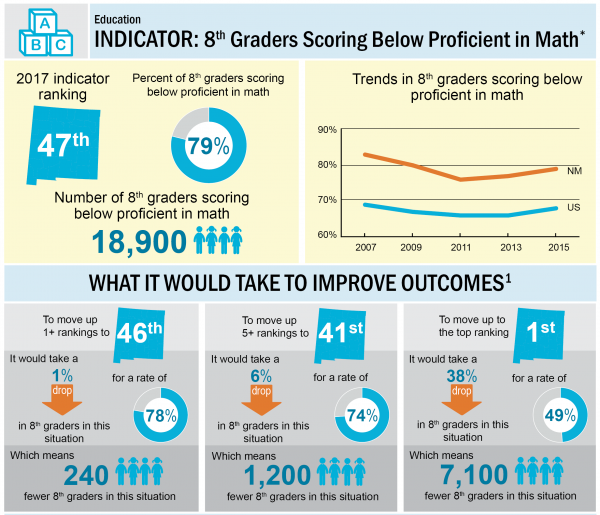 *Eighth graders scoring below proficient in math on the National Assessment of Education Progress (NAEP).
*Eighth graders scoring below proficient in math on the National Assessment of Education Progress (NAEP).
What New Mexico Can Do
- Expand high-quality early childhood care and education services to help prepare children for school and increase the likelihood they will reach grade-level benchmarks on time.
- Expand funding for K-3 Plus so more low-income students will have the additional quality instructional time they need to bring them up to grade level.
- Expand K-3 Plus to a K-8 Plus program because children in low-income families still need extra supports beyond 3rd grade.
- Expand quality before- and after-school, mentorship, and tutoring programs to provide added academic assistance to low-income and low-performing students, or those whose parents may not be able to help them with their homework.
- Provide math coaches and professional development for math teachers.
- Implement systems to identify and address chronic absenteeism.
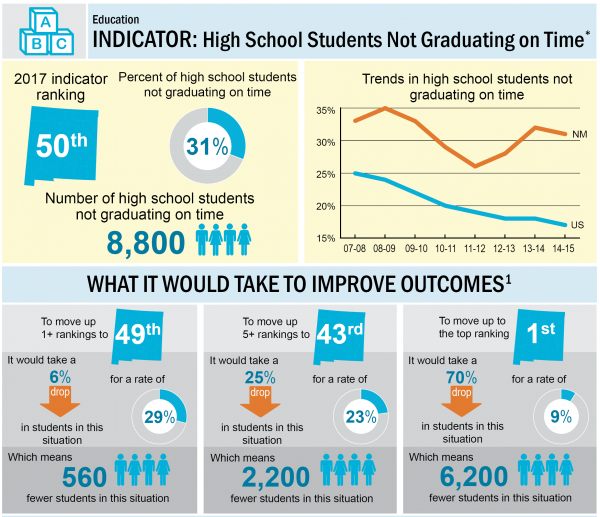 *Members of a freshman class not graduating in four years according to the Adjusted Cohort Graduate Rate. This is not the same as the drop-out rate.
*Members of a freshman class not graduating in four years according to the Adjusted Cohort Graduate Rate. This is not the same as the drop-out rate.
What New Mexico Can Do
- Provide more school counselors.
- Provide free summer school, after-school and online learning to students requiring additional learning time.
- Provide relevant learning opportunities through service learning, technical education, internships, and dual credit programs to better prepare students for career or college.
- Support dropout prevention and dropout recovery programs.
- Provide support for vulnerable students (those experiencing homelessness, who are incarcerated, need special education, are English language learners, etc.) who are at risk for dropping out.
- Increase funding for evidence-based teen pregnancy prevention programs.
- Ensure support for community schools, which provide services shown to increase academic performance.
- Reduce and limit zero-tolerance policies and penalties in order to keep more students in school.
- Implement systems to identify and address chronic absenteeism.
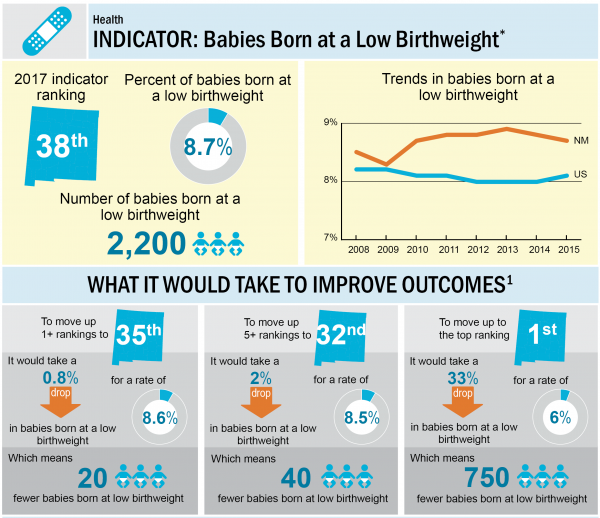 *Babies born weighing less than 5.5 pounds.
*Babies born weighing less than 5.5 pounds.
What New Mexico Can Do
- Expand outreach to pregnant women to enroll them in Medicaid early in their pregnancy so more prospective mothers get full-term pre-natal care that can help prevent low birthweight.
- Provide adequate funding for more programs for new parents, including home visiting programs that begin prenatally, so more women can be served during their pregnancy.
- Expand and fully fund health and nutrition programs for pregnant teens.
- Support the creation and funding for county and tribal health councils.
- Fund home visiting under a Medicaid waiver to draw down federal funding.
- Expand the use of promotoras.
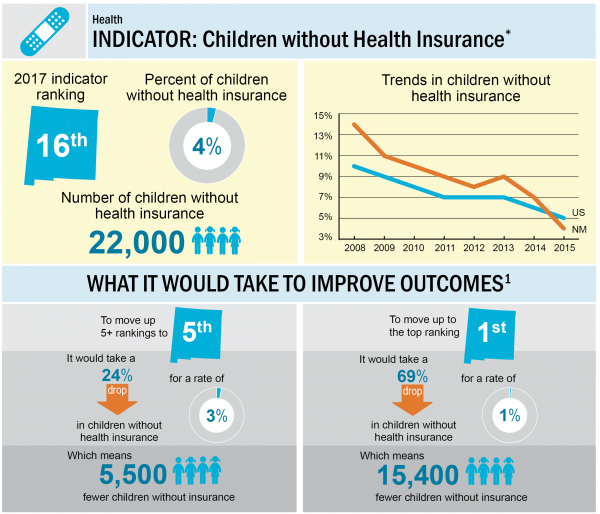 *Children (ages 0-17) without private or public (Medicaid/CHIP) health insurance.
*Children (ages 0-17) without private or public (Medicaid/CHIP) health insurance.
What New Mexico Can Do
- Restore outreach and enrollment programs for Medicaid to help cover those children who are eligible for Medicaid but still not enrolled.
- Integrate the health insurance marketplace with Medicaid so there is “no wrong door” for enrollment to help low-income parents who are getting coverage for themselves, enroll their Medicaid-eligible children at the same time.
- Simplify the Medicaid enrollment and recertification process for children, and enact express-lane enrollment, which would help the state identify eligible children using information from other programs like Head Start and SNAP (food stamps).
 *The number of child and teen deaths per 100,000 children and teens (ages 1-19). This measure does not include children who die in their first year of life.
*The number of child and teen deaths per 100,000 children and teens (ages 1-19). This measure does not include children who die in their first year of life.
What New Mexico Can Do
- Support and expand quality home visiting for families identified as high risk for child abuse and neglect in order to help improve social and physical outcomes for infants and young children.
- Expand funding for suicide prevention programs to provide youth with supportive adults, strategies to cope with difficult situations, and a sense of hope.
- Enact stronger gun safety laws to limit unauthorized child access to guns to decrease accidental deaths.
- Adequately fund evidence-based child abuse prevention programs and strengthen the Children, Youth and Families Department’s role in prevention.
- Continue to increase funding for child protective services in order to reduce caseloads.
- Create a citizen oversight or review board for all CYFD child abuse cases that result in death.
- Include adverse childhood experiences (ACEs) in Early and Periodic Screening, Diagnostic and Treatment (EPSDT) protocols.
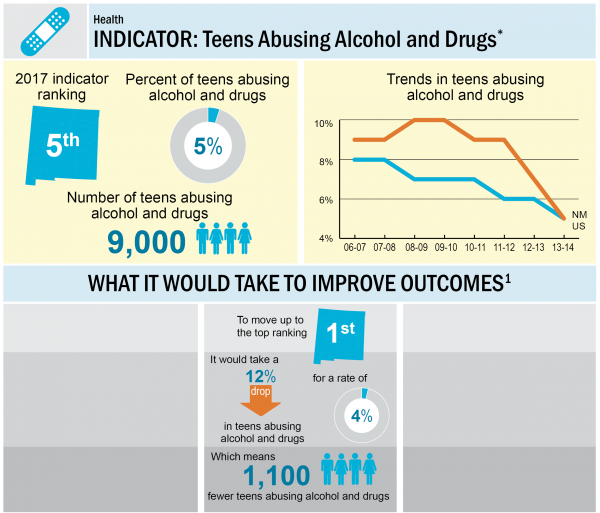 *Youth (ages 12-17) who reported abusing alcohol or drugs within the past year.
*Youth (ages 12-17) who reported abusing alcohol or drugs within the past year.
What New Mexico Can Do
- Expand mental health programs for children, youth and families.
- Expand funding and support for school-based health centers (SBHCs) so students have access to physical and mental health services they might not otherwise get, including confidential and developmentally appropriate behavioral health services in a safe, accessible place.
- Support the creation of and funding for county and tribal health councils in order to better reach young people who are attempting to self-medicate an untreated mental health problem with alcohol and drugs.
- Fund drug and alcohol rehabilitation services for youth, especially at an early intervention stage—as opposed to incarcerating youth for alcohol-related offenses— to help prevent further problems and reduce high rates of recidivism.
 *Children (ages 0-17) who live with their own single parent either in a family or subfamily. Single-parent families may include cohabiting couples.
*Children (ages 0-17) who live with their own single parent either in a family or subfamily. Single-parent families may include cohabiting couples.
What New Mexico Can Do
- Expand funding for home visiting programs, especially for teen parents. Home visiting provides parents with early emotional support, parenting skills, developmentally appropriate activities, and aid in accessing community economic, health, and educational resources.
- Increase eligibility for child care assistance to at least 200 percent of the federal poverty level, so greater numbers of low-income families headed by single parents can afford child care.
- Expand funding for mentorship and other pregnancy prevention programs for teens.
- Support career pathways approaches that better align adult education with post-secondary education opportunities and industry needs and that provide a clearer ladder to economic self-sufficiency.
- Maintain current Medicaid eligibility for family planning services.
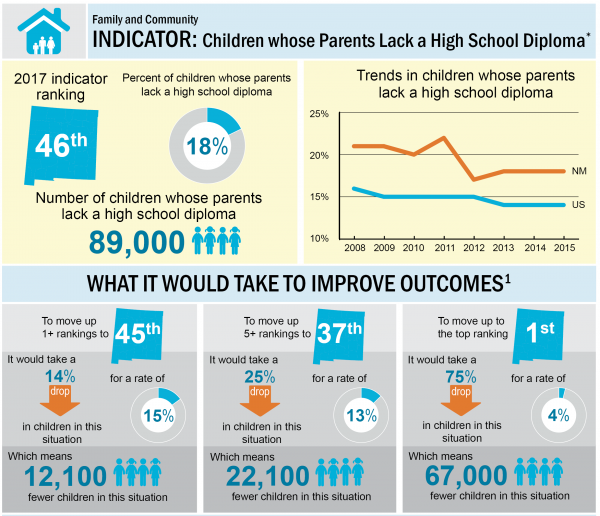 *Children (ages 0-17) in families where the household head lacks a high school diploma.
*Children (ages 0-17) in families where the household head lacks a high school diploma.
What New Mexico Can Do
- Expand access to high school equivalency programs, adult basic education, post-secondary education, and job training through a career pathways approach.
- Provide need-based financial aid for low-income and low-skilled adults seeking entry into these programs.
- Expand funding and access for English as a second language (ESL) classes to help parents increase their levels of education.
- Fund alternative high schools and evidence-based drop-out prevention programs, including drop-out recovery programs that combine education, job training, and youth development.
- Expand access to education-oriented youth employment and career exploration programs including paid summer jobs and internships, on-the-job training, career technical education (CTE), and pre-apprenticeships.
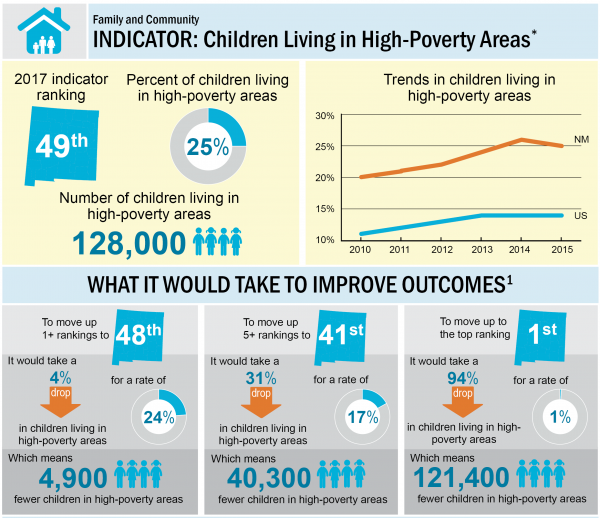 *Children (ages 0-17) living in census tracts where 30 percent or more of the residents live at or below the federal poverty level.
*Children (ages 0-17) living in census tracts where 30 percent or more of the residents live at or below the federal poverty level.
What New Mexico Can Do
- Increase access to affordable housing in safe areas with prospects of work for low-income families by expanding incentives for developers to build mixed-income housing developments.
- Promote community change efforts that integrate physical revitalization with human capital development.
- Increase funding for Individual Development Accounts (IDAs), which help parents and children save money for buying a home or paying for college.
- Target strategic economic development strategies that create jobs with livable wages in high-poverty areas.
- Target federal funds to support education and job training programs that help parents increase their educational attainment and workforce skills, and create pathways out of poverty.
- Increase wages and incomes for low-income workers through policies like an increased Working Families Tax Credit and a higher minimum wage.
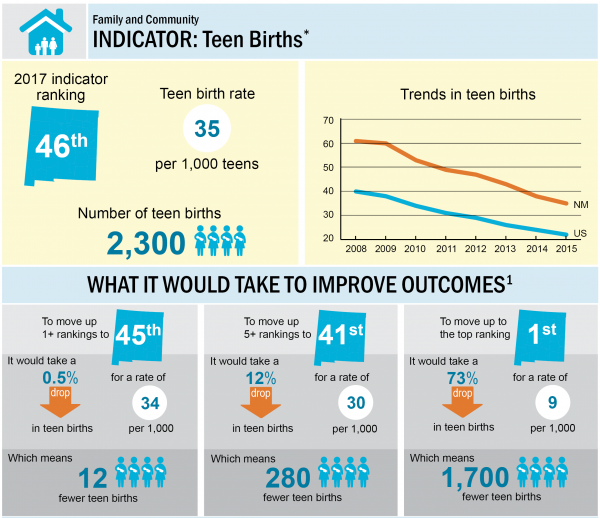 *The number of births to teens (ages 15-19) for every 1,000 females in that age group.
*The number of births to teens (ages 15-19) for every 1,000 females in that age group.
What New Mexico Can Do
- Increase funding and support for teen pregnancy prevention and support programs to help at-risk young women avoid pregnancy, and see alternative opportunities for their future.
- Expand funding and support for school-based health centers (SBHCs) and county and tribal health councils in order to ensure teen access to health professionals and better integrate health care with social, emotional, behavioral and cognitive development for teens.
- Expand evidence-based, age-appropriate sex education and defund abstinence-only programs.
- Expand funding for mentorship and other pregnancy prevention programs for teens.
- Increase teen participation in extra-curricular activities including sports, after-school and summer learning programs, as well as community service and work experience opportunities.
Endnotes
1. Ranking improvement estimates are based on point-in-time data reported in 2016; changes in other states’ outcomes can also influence New Mexico’s future rankings. Also, because states can tie in indicator rankings it may take more than 1 or 5 rankings in order to move up.
Rankings Source:
KIDS COUNT Data Book, Annie E. Casey Foundation, 2016 and 2017
Data Sources:
Children Living in Poverty: U.S. Census Bureau, American Community Survey (ACS), 2006-2015
Children in Families without Secure Employment: Census Bureau, ACS, 2008-2015
Children Living in Households with High Housing Cost Burdens: Census Bureau, ACS, 2008-2015
Teens Not in School and Not Working: Census Bureau, ACS, 2008-2015
Young Children Not in School: Census Bureau, ACS, 2007-2015
Fourth Graders Scoring Below Proficient in Reading: National Center for Education Statistics, National Assessment of Educational Progress (NAEP), 2007-2015 and New Mexico Public Education Department (NM PED) Enrollment by Grade, 2016
Eighth Graders Scoring Below Proficient in Math: National Center for Education Statistics, NAEP, 2007-2015 and NNM PED Enrollment by Grade, 2016
High School Students Not Graduating on Time: U.S. Department of Education, National Center for Education Statistics, Common Core of Data (CCD), 2007-2015 and NM PED Enrollment by Grade, 2011
Low-Birthweight Babies: Centers for Disease Control and Prevention (CDC), National Center for Health Statistics (NCHS), National Vital Statistics Reports, 2008-2015
Children without Health Insurance: Census Bureau, ACS, 2008-2015
Child and Teen Deaths: CDC, NCHS, Multiple Causes of Death Public Use Files for 2008-2015
Teen Alcohol and Drug Abuse: Substance Abuse and Mental Health Services Administration, National Survey on Drug Use and Health 2006 to 2014
Children in Single-Parent Families: Census Bureau, ACS, 2008-2015
Children in Families where the Household Head Lacks a High School Diploma: Census Bureau, ACS, 2008-2015
Children Living in High-Poverty Areas: Census Bureau, ACS, 2008-2015
Teen Birth Rate: CDC, NCHS, National Vital Statistics birth data, 2008-2015
Download this report (April 2018; 20 pages; pdf)
